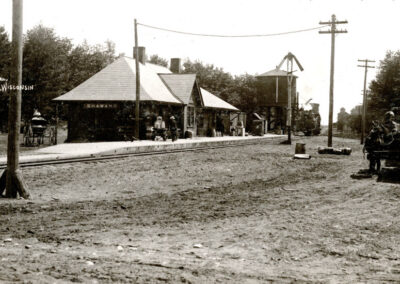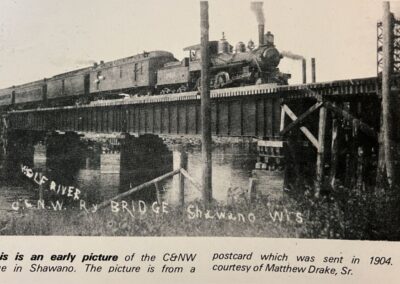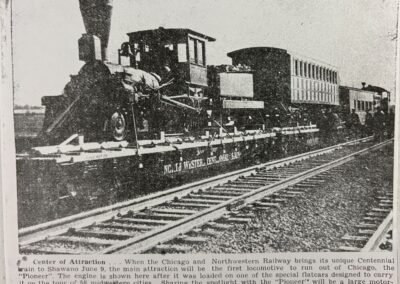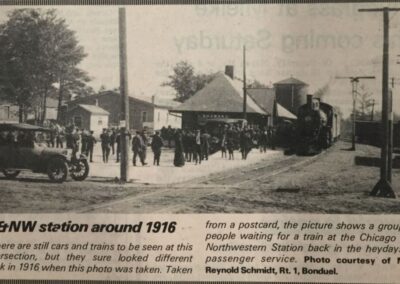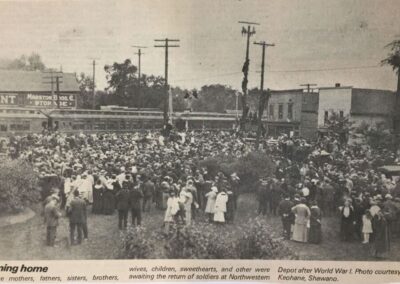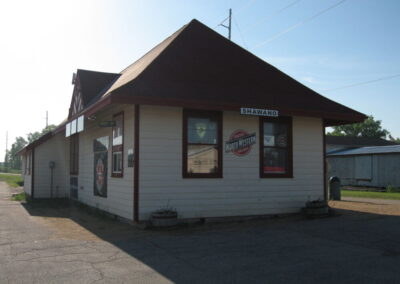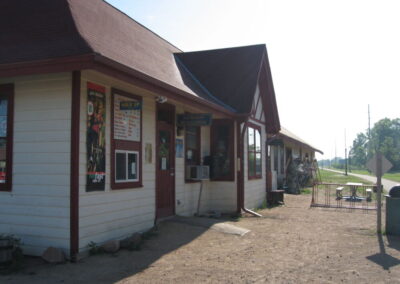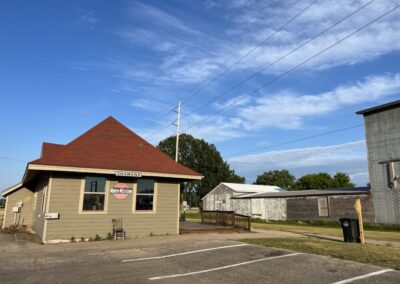Location
Photo Gallery
A Brief History
The Chicago & North Western Depot
620 South Main Street
Shawano, Wisconsin
The first Chicago & North Western Depot was located at what was the south end of Union Street. There, it served the stock yards where cattle were shipped to market. A depot was later constructed on Main Street and the old depot abandoned and eventually demolished. After the C&NW Depot on south Main Street was constructed, two hotels, the Northerwestern Hotel and Mahl Hotel, as well as the Comfort Barbershop, were built to serve the arriving railroad passengers.
Shawano had two railroad passing through the city. The Soo Line rail entered the east and existed through the north on east Green Bay Street and over the Shawano Lake Channel. The Chicago & North Western entered the east and existed through south Main Street and over the Wolf River to the west. Its no accident that businesses and industry located along the rail lines. Most notably, the Wolf River Paper & Fiber Company, now Shawano Paper Mills.
As Shawano grew, so did rail freight and passenger rail traffic. Railroads in Shawano and northern Wisconsin grew and flourished from the late 1800’s until after WWII and into the 1950’s until the automobile took over as the main mode of transportation in the United States.
Railroad Memories
By George Putz
The passing of an era has left a scar through the heart of Shawano. Where steel rails of the Chicago & North Western Railroad once traversed the city there remains today only a ribbon of mutilated earth and blacktop patches across city streets. This rail line through Shawano was originally built in 1884 by the St. Paul & Eastern Grand Trunk from Clintonville to Oconto, connecting with Chicago & North Western lines at those cities. Only a few years after the line was built it was acquired by the Milwaukee Lakeshore & Western Railroad. In 1893 the Chicago & North Western absorbed the entire Milwaukee Lakeshore & Western system and in 1905 built a line from Green Bay to Eland, integrating into it the existing tracks through Shawano. By 1928 it was no longer profitable to operate trains between Clintonville and Oconto and in September of 1935, an announcement was made that the line would be abandoned and that the tracks would be removed by the first of November. All that would remain were the rails through Shawano, which had been integrated into the Green Bay-Eland line.
There is little doubt that the place selected by the railroad in 1884 to bridge the Wolf River was influential in selection of a site just some 400 feet upstream for construction of the dam in 1892, and consequently the Wolf River Paper & Fiber Company, locating there in 1894, at the west end of the dam. At the east end of the dam, in 1892, J. D. Kast built a gristmill, to which a sidetrack was extended.
In 1889 a track was built to the Madison Lumber Company steam saw mill which had been built in 1873 along the west end of Wescott Avenue. The track went to some distance south of where Lieg Avenue is now located, its “ghost” roadbed was still visible on the landscape south of the avenue until 1994 when it was obliterated by construction of the boat landing there.
A 1911 plat map of the city shows that both of these sidetracks still existed at that time. Evidence of the old saw mill still exists today. About 50 feet north of Wescott Avenue there is a cut in the river bank and wood piling in the river which are probably remnants of the mill’s log slip.
At the time I started working at the paper mill in 1943, steam locomotives were still the railroad workhorses. One of them making daily visits to the mill bringing carloads of pulp and taking out carloads of finished paper, was C.N.W. Engine No. 1409. I think it was sometime in the early 1950’s that one day a bright yellow diesel engine made its first appearance at the mill and we would never see the faithful old steamer again. In the 1940’s there were still a few of the old 36 foot boxcars in use and occasionally one would be brought to the mill to be loaded with paper. These antiquated cars had tie rods underneath their floors, which sometimes furnished transportation for hobos riding the rods.”
The newer cars were forty footers and no longer had tie rods. Eventually fifty-foot cars became prevalent with even some sixty footers.
At what was, at the time, the south end of Union Street were the stock yards from where cattle were shipped to market in slat sided cattle cars, but like steam engines, the stock yards and cattle cars would become railroad history. Shawano’s first depot was also located at the south end of Union a pine. A depot was later constructed at the Main Street site, which is was Joe Bikler’s for years. In the 1930’s a pine woods just south of the tracks at the end of Union Street was a “hobo jungle” what was the Phoenix plant.
The Chicago & North Western depot in Shawano must have been a very busy place at one time with passenger trains arriving and departing several times daily. Eventually this dwindled to just two trains, the Ashland Limited, with a southbound Ashland to Chicago unit arriving in Shawano about 11:00 p.m. and a northbound unit, Chicago to Ashland, which arrived in Shawano about 1:00 am
The other passenger train was a gasoline powered, single unit coach which every day, except Sunday, made a mid morning trip from Green Bay to Eland and returned to Green Bay in mid afternoon.
Shawano Evening Leader Article – March 22, 1993
By Fred Gruner
A casual announcement by the Chicago and North Western Transportation Co. in the Shawano Leader indicating intent to abandon 83.4 miles of rail line between Green Bay and Wausau via Shawano, sadly notes the end of an era.
This is the story of that era, an era symbolized by what was one of the nation’s greatest passenger trains – the “Flambeau 400.” It’s a story of a train’s birth, zenith and demise, told as it passed through Shawano on its way into history.
Excitement abounded on May 27, 1950 when Shawano’s mayor David H. Winter proudly cut the ribbon in front of the shining nose of an E unit diesel. This was a suit-and-tic occasion in celebration of the streaml iner “Flambeau 400’s” first southbound trip from Ashland.
In addition to railroad dignitaries, Shawano leaders included Chamber of Commerce President, Harry Meyer and Secretary Oscar Ramlow. Mayor Winter presented a 3-foot key for the city to engineer H. A. Webber.
The ribbon cutting ceremony was the successful culmination of the city’s effort and hope that the new passenger train would be routed through Shawano. Historically, passenger and freight service from Chicago and Milwaukee to the mining and resort areas of Wisconsin’s north woods and Michigan’s UP was of extreme importance to the Chicago and North Western Railroad (CNW).
The main line terminated 452 miles from Chicago at Ashland; principal cities served included Ironwood, Rhinelander, and Anti-go. A branch line to Watersmeet served Eagle River and Three Lakes. At Eland the line split, offering two routes south to Chicago: one through Green Bay and Shawano; the other via Clintonville and Oshkosh. (The Shawano route traversed 69.7 miles of the soon to be extinct Green Bay to Wausau Line.)
Routing the new train through Shawano was not a forgone conclusion. Traffic generally used the 33-mile shorter Clintonville line. Clintonville actively lobbied for the new train. Shawano responded. “Silence is not golden,” screamed a Shawano Evening Leader editorial, exhorting the new train’s importance to Shawano.
Began in 1935
It all began June 21, 1935 with the start of a new limited passenger service from Chicago to the north woods by the CNW. Near Manitowish, the train ran through the Lac du Flambeau Indian reservation. Early French traders had given the tribe the name “flambeau,” French for “flaming torch,” from their use of torches for night fishing. The train was given the appropriate name: “Flambeau.”
The “Flambeau” ran on summer weekends, via Clintonville, to Ironwood and Watersmeet. It was an impressive consort: a Pacific type steam locomotive, typically 10 olive drab heavy weight cars, including a diner (featuring $0.65 dinners), and parlor cars.
The train was such a success – carrying upwards of 400 passengers – that it was put on a daily summer schedule and extended to Ashland in 1937. July 9, 1938 was a great day for Shawano: the “Flambeau” was diverted from Clintonville and rerouted through Shawano and Green Bay. By providing direct service between Green Bay and the north, the C&NW hoped for additional traffic. Hence forth and until the end, the Flambeau and its predecessor would run through Shawano.
War brought change
World War II brought many changes. The “Flambeau” was suspended for the war’s duration. Also, the war years, with the curtailment of other modes of transportation, brought a cornucopia of passengers to the railroads. The railroad titans deluded them-selves, despite the looming automobile competition, that post war passenger business would be a profitable endeavor. Never was the consensus of an industry to be proven so wrong. CNW was no exception to such delusions. In postwar earnest it expanded its “400” stream liner passenger fleet as fast as new equipment became available.
With the war’s end, the “Flam-beau” was reinstated in August 1945, daily, summer only, with the same prewar equipment.
However, by 1949 new equipment began to arrive. A gleaming new E 7 diesel appeared, though steam occasionally was subbed. The train became a mixture of coaches: old pre-war heavies and new yellow and green light weight streamlined.
“Doodlebug’ service
Shawano had other passenger trains in 1949. There was the Ashland Limited; though primarily a mail express train, it did carry a cafe-lounge car, sleeper, and coach-es. Its arrival around midnight, caused it to be referred to as “the midnight train.”
And then there was the “doodle-bug,” a daytime motor car from Green Bay to Eland. In addition to Shawano, stops included: Zachow, Bonduel, Thornton, Lyndhurst and Bowler, as it leisurely covered the 66 miles in 2 hours 20 minutes. While the brunt of many jokes, a “doodlebug” ride to Bonduel was a graduation treat for Lincoln School classes; and at Christmas Santa Claus arrived via the “doodlebug.” With the advent of the “Flam-beau 400” the “doodlebug” was terminated, ending passenger service to most of Shawano County’s smaller communities.
Ribbon cutting in Shawano
All the “Flambeau’s” past was culminated with Shawano’s ribbon cutting ceremony. Upgraded with new streamline equipment, it was renamed “Flambeau 400” the newest member of the C&NW’s elite “400” fleet.
The “Flambeau 400” was a remarkable train by any context and an instant success. The CNW 1950 annual report noted: “The Flambeau 400 was very well received and patronized.” The train provided year around, daily, daytime service, Chicago to Ashland 90 minutes faster than the competing bus with connecting train service to Waters-meet and Eagle River.
The train was stunning in its 10-car mix of coaches: a baggage diner, RPO-express, and two parlor. cars. Their midday arrivals created a busy afternoon for Shawano’s South Main Street depot.
However, 1950 was late in the day for passenger trains. Economic success would continue for two brief years, our which the lake-would began to flicker and eventually fade into the night.
First cutback in ’52
The first cutback occurred in 1952; parlor and dining cars were eliminated in the off-winter season. 1956 was the year of reality for C&NW passenger trains the beginning of the end of passenger service. Passenger losses, from expanding automobile competition, had pushed the railroad to the verge of bankruptcy. (Wisconsin passenger losses of $7,832,000 exceeded freight revenue by $1,867,000).
The C&NW appealed to the Public Service Commission to curtail 21 passenger trains. Included was the “Flambeau 400.” Since the average passenger load had dropped to just 33.3 in the off season, it was proposed that buses be substituted, October through April. The commission approved all proposed changes except the “Flambeau 400” as revenue still covered its out-of-pocket expenses.
As a last-ditch effort, the C&NW purchased bi-level coaches. In May 1962 they appeared on the “Flam-beau 400.” As the bi-levels could seat 96, two coaches could handle the usual passenger load. The new construct: two bi-level coaches, an RPO-baggage car and occasionally a couple of old heavyweight storage-mail cars tacked to the end of the train, required only a single E unit diesel.
The bi level coaches proved to be disappointingly austere.
A final blow
In 1968 occurred the final blow: the U.S. Post Office canceled rail postal handling. The loss of mail revenue, coupled with continued declining passengers, produced annual losses of $500,000. Permission was granted for summers-only service, with substitute bus service the rest of the year.
Interestingly, the bus maintained the same schedule as the train, a result of improved highways and deteriorated rails. As if to conceal the victim’s identity, the name “Flambeau 400” was dropped, replaced by three-digit numbers.
The last seasonal run on Jan 5, 1971 proved to be the final trip for the “faming torch.” The following spring Amtrak relieved all railroads of passenger obligations. Only one long-distance Wisconsin train survived – the “Flambeau 400” did not.
Last run in ’82
And what of the path of the “Flaming Torch”?
The last freight left Ashland Nov. 1983, behind which the line was torn up as far south as New London. (The Watersmeet branch had been abandoned shortly before).
Soon to be abandoned Shawano line operated by the Fox River Valley Railroad (FRV) for the C&NW, frequented by a daily freight, its 20 or so cars undulating slowly along the ill-maintained track.
If you believe in ghosts, stand by the track when the FRV freight creeps in. Close your eyes and imagine the diesel’s sounds coming from ghost trains of the past “Ashland Limited” “Doodlebug,” and grandest of them all: the stream liner with the strange French name “Flambeau 400.”
Ah, “Flambeau 400” air horn blaring and head light oscillating.

